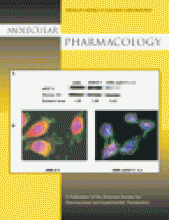Abstract
The therapeutic targeting of nicotinic receptors in the brain will benefit from the identification of drugs that may be selective for their ability to activate or inhibit a limited range of nicotine acetylcholine receptor subtypes. In the present study, we describe the effects of 2,2,6,6-tetramethylpiperidin-4-yl heptanoate (TMPH), a novel compound that is a potent inhibitor of neuronal nicotinic receptors. Evaluation of nicotinic acetylcholine receptor (nAChR) subunits expressed in Xenopus laevis oocytes indicated that TMPH can produce a potent and long-lasting inhibition of neuronal nAChR formed by the pairwise combination of the most abundant neuronal α (i.e., α3 and α4) and β subunits (β2 and β4), with relatively little effect, because of rapid reversibility of inhibition, on muscle-type (α1β1γδ) or α7 receptors. However, the inhibition of neuronal β subunit-containing receptors was also decreased if any of the nonessential subunits α5, α6, or β3 were coexpressed. This decrease in inhibition is shown to be associated with a single amino acid present in the second transmembrane domain of these subunits. Our data indicate great potential utility for TMPH to help relate the diverse central nervous system effects to specific nAChR subtypes.
- Received February 1, 2005.
- Accepted March 10, 2005.
- The American Society for Pharmacology and Experimental Therapeutics
MolPharm articles become freely available 12 months after publication, and remain freely available for 5 years.Non-open access articles that fall outside this five year window are available only to institutional subscribers and current ASPET members, or through the article purchase feature at the bottom of the page.
|






